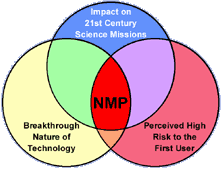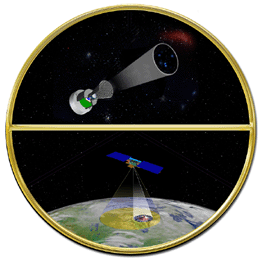NASA missions have become progressively more daring and thus more difficult. We have ventured to the moon, explored other planets, travelled to the edges of our Solar System, and peered back in time. We have also done what is sometimes even more difficult——studied our own planet. Today there are no easy missions left for us to do.
To achieve its future goals, NASA needs a spacecraft brimming with new capabilities, inventions, and technology. However, there are risks in using new, untried technology in actual missions. It is much more difficult to design "gadgets" for space than for everyday applications here on Earth. This is because space is a harsh and hazardous environment of zero pressure, extreme temperatures, and deadly high-energy particles that can't be reproduced in Earth laboratories. Before a new concept or technology is used for the first time in an expensive spacecraft, NASA engineers want to make sure that it will operate well in this harsh environment. They do this by designing experiments to test during space flight.
 |
NMP Process
|
NASA's New Millennium Program (NMP) was created to conduct such experiments. NMP provides a important bridge between the development and the operation of new technologies. Through NMP, researchers and scientists are able to check out high-risk technologies and concepts in the actual environment of space. Only after their performance is successfully demonstrated can new concepts and technologies be used on an actual space exploration mission.
NMP's Space Technology 6 (ST6) has two such technologies for validation: Autonomous Sciencecraft Experiment (Sciencecraft) and Inertial Stellar Compass (Compass). Sciencecraft enables a spacecraft to decide what science observations to make, and then process and return data——all on its own. Compass enables a spacecraft to continuously sense its position and recover after a temporary malfunction or power loss. Many features of these two technology systems are "firsts" that have never before been used in space.
 |
A duo of technologies.
|
The Sciencecraft experimental technology has been on its validation flight since early 2004, onboard NMP's in-flight Earth Observer 1. Compass was flight tested on the TacSat-2 microsatellite, which launched in December 2006. While each technology was flown on separate flight vehicles, the common goal of the two experiments is to free the spacecraft from its continuous link with the ground. These capabilities, heavily laced with artificial intelligence, will not only make future spacecraft better, but also less expensive by not requiring ground operators to supervise the spacecraft around the clock.
Successful validation of these technologies will enable future spacecraft to independently make decisions, figure out what to observe, plan activities, find and recognize destinations, and never get lost in space.
The validation process included:
- flying over active volcanoes and flood areas to determine whether the "artificial scientist" can collect meaningful data on these interesting regions.
- using stars to precisely recognize the spacecraft direction.
The capabilities of ST6 technologies are critical to the success of several future NASA missions.